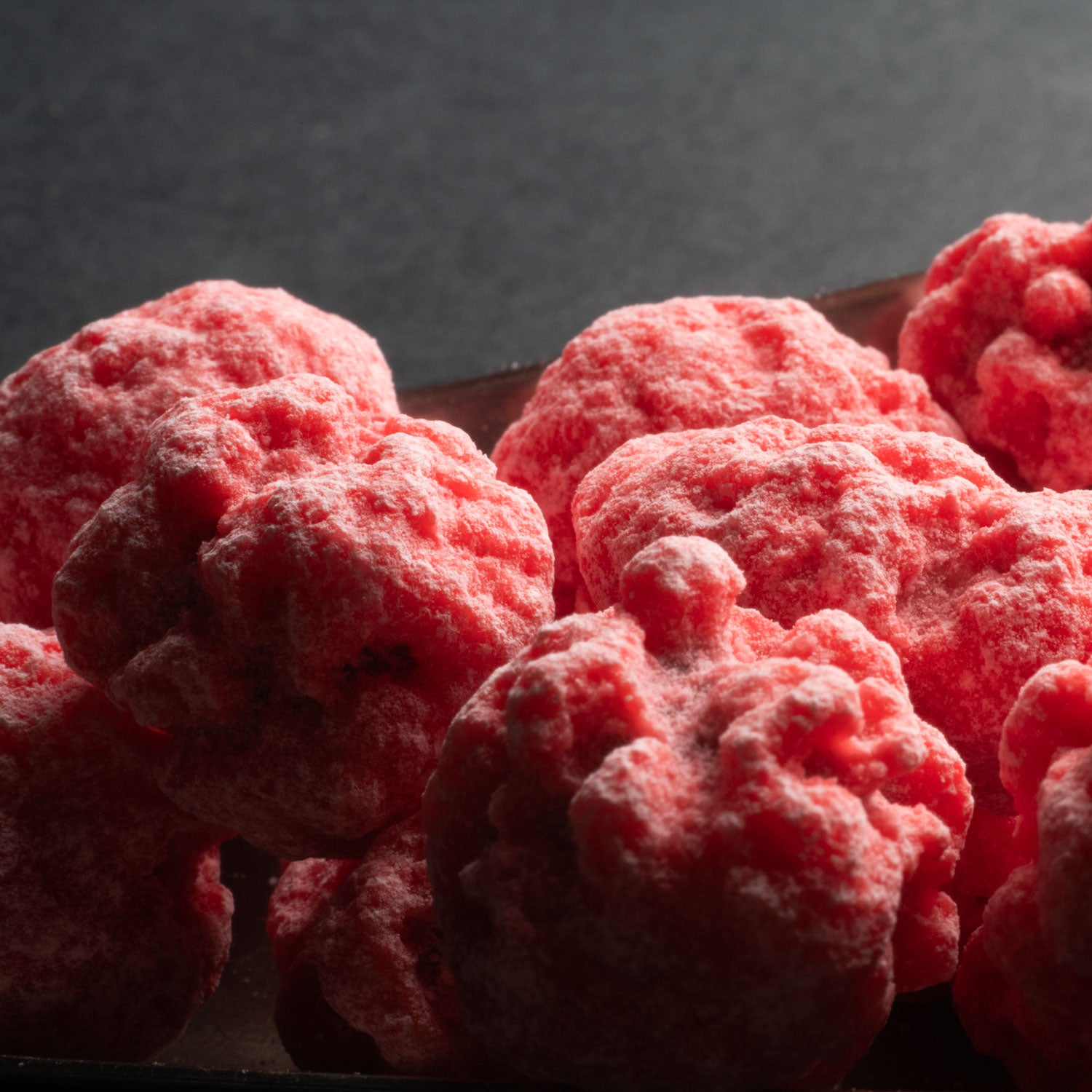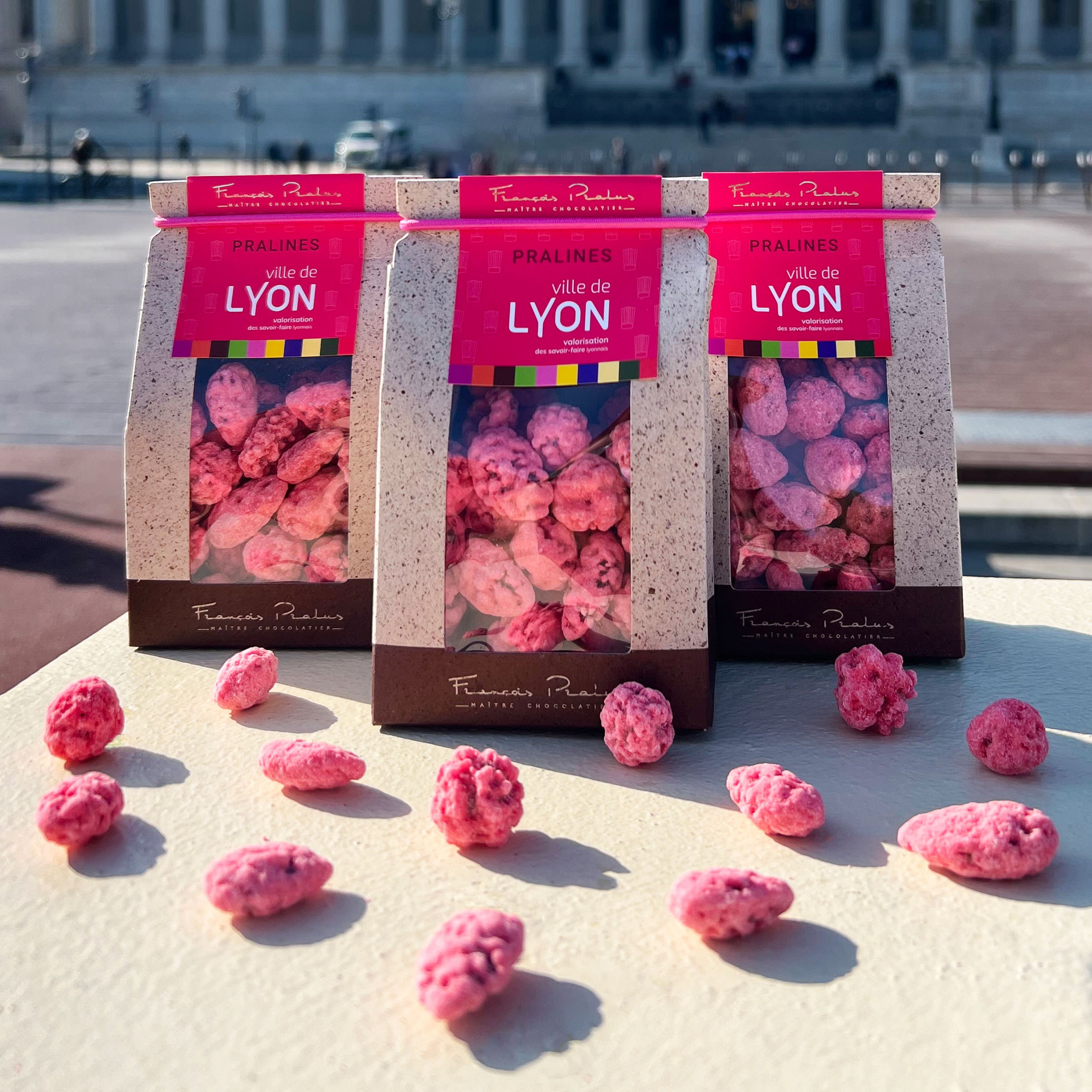The Pralus de Roanne Manufacture is also recognized for the quality of its finely roasted pralines, almonds and hazelnuts coated with pink sugar. This candy marked the history of the house since it led to the creation of Praluline, in 1955. An idea from Auguste Pralus, Meilleur Ouvrier de France, to use unsold pralines in his Roanne pastry and respond to the demand from its customers.
“Pink gold” from Maison Pralus is Valencia almonds and Piedmont hazelnuts, rigorously selected, nestled in a shell of pink sugar. Once roasted to the core, hazelnuts and almonds are coated in sugar, in successive layers. Ladle by ladle, the pastry chef distributes the boiling sugar mixture into the copper turbine. Almonds and hazelnuts gradually become colored... This operation is patiently repeated for an hour for around twenty kilos of fruit.
Every day, 1,200 kilos of pralines come out of the Manufacture's turbines. Most will then be crushed to garnish the Pralulines made in Pralus stores, or bagged for tasting.
A little history of pink praline
Before being pink, the praline was brown or gray and its history varies depending on sources and departments.
One thing is certain, the history of this confectionery begins at the beginning of the 17th century when Clément Jaluzot, catering officer of the Count of Plessis-Praslin, manufactured this confectionery. Pastry error or not, fallen into sugar or not, these almonds coated in caramelized sugar really please the gourmet count. He had them served, in gold spoons, during a sumptuous dinner in Bordeaux in 1749. They were named pralines by their creator in homage to his master.
Clément Jaluzot then opened his own confectionery in Montargis, where he made his fortune. Renamed “Aux Ducs de Praslin”, his house was taken over by Léon Mazet, who gave his name to a house still renowned today for its pralines among other sweets.
This is how the ancestor of the Pink Praline was born, which apparently dates from the 19th century and would have been created in Savoie or not far away, in the Rhône. In any case, today it is a specialty of Rhône-Alpes and Dauphiné. Its color was given to it by a natural dye, cochineal.
The first recipe with pink pralines is Gâteau de Saint Genix created in 1860 by Pierre Labully in Saint-Genis-sur-Guiers. The pastry chef incorporated pralines into his dough which melted into his brioche. Called Gâteau Labully, his creation was sprinkled with praline and sugar.
Since Lyon is only 80 km away, over time we see brioches with pink pralines appearing in bakeries, which have become a specialty of the city.
In 1955 in Roanne, responding to demand from his customers, MOF pastry chef Auguste Pralus created his own pink praline brioche, Praluline®, whose success has continued ever since.
Pink pralines, known as Lyon pralines, were also used in a praline tart, which chef Alain Chapel put on his menu in 1975. This pastry has become a classic of Lyon desserts.
The Praline macaron
A specialty of our Roanne factory, pink praline excites creativity at Pralus! We see or taste life in pink, with a praline macaron that completes our range. Under a powdered pink praline shell, quite simply a cream of pink pralines. All pink, our macaron will surprise you with the flavor of Valencia almonds and roasted Piedmont hazelnuts which characterizes our pink pralines.
Crunchy, Praline Shortbread!
You like pink pralines, you will fall for our shortbreads! Well buttered as we like at Pralus, these biscuits are full of finely crushed pink pralines, almonds and roasted hazelnuts. A tribute from our pastry chefs to “the pink gold of Pralus”.
These shortbreads are made the old-fashioned way with homemade pralines which give them their color, sugar and flavor of roasted dried fruits. They are available in 250 gram sachets in all Pralus stores.
Pink Praline ice cream
The latest addition to the range coming out of the turbines of our ice cream shop, pink praline ice cream has become a must in our region which celebrates praline on the dessert menu or in family recipes. Full of delicious bits of pink praline which give it its pastel hue, it is available in half-liter pots in stores only, alongside our 11 organic flavors.





